[jwplayer 18QegcJn-sNi3MVSU]
Week 7 DPI Rankings: Lobos Rising After Six-Game Streak
The top two stand pat, but plenty of movement below
Contact/Follow @andrewdieckhoff & @MWCwire
New Mexico, Boise State climbing in the latest DPI rankings for Week 7
It was back to non-conference play last week for the league’s affiliate members on the heels of the opening salvo to the long Mountain West season. Not everybody was in action—and some now wish they hadn’t been.
But it wasn’t all misery.
Some teams are making big strides, including one squad trying to make a move into the uppermost echelon of the MWC.
Below are the DPI rankings heading into the heart of Week 7. If you’re new to the rankings or just want a refresher, head here for a rundown of how the DPI is calculated. The ratings below reflect games played through Tuesday, December 17. As always, non-Division I games are not counted in the DPI.
[lawrence-related id=23624]
#1 — SAN DIEGO STATE AZTECS
Last Week: #1
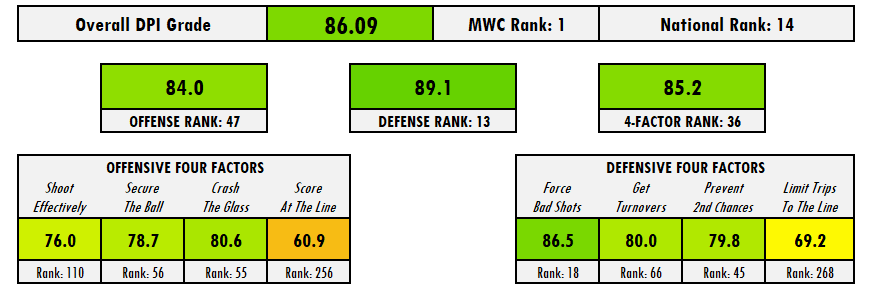
The Aztecs moved to the #1 spot in the Mountain West last week and with no games since their close shave against San Jose State, they haven’t moved much up or down. Brian Dutcher’s team is still undefeated and boasts one of the best defenses in the country. Malachi Flynn’s star turn has propelled SDSU into the national polls, along with the play of Matt Mitchell, Yanni Wetzell, and Jordan Schakel. If KJ Feagin can provide a little more offense, this team could really turn in a special season.
#2 — UTAH STATE AGGIES
Last Week: #2
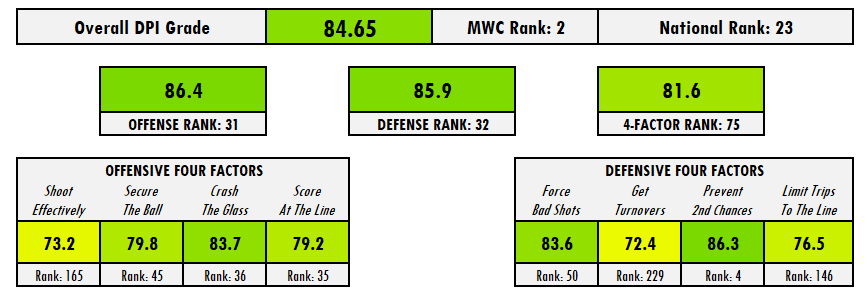
It’s been a bit of a rough patch for the Aggies over the past few games. They still have one of the two best rosters in the league, but they aren’t quite living up to preseason expectations so far. After losing to Saint Mary’s and looking underwhelming in their first two Mountain West games, Utah State fell to BYU on Saturday in Salt Lake City. It was only their second loss, but it’s a missed opportunity for a good out-of-conference win to put on their NCAA Tournament resume.
Lobos are now 8-0 at home and 6-0 in December! Last time UNM went 6-0 in December was the 2011-12 season. #GoLobos pic.twitter.com/KK8TQSbo2G
— Lobo Basketball (@UNMLoboMBB) December 18, 2019
#3 — NEW MEXICO LOBOS
Last Week: #4
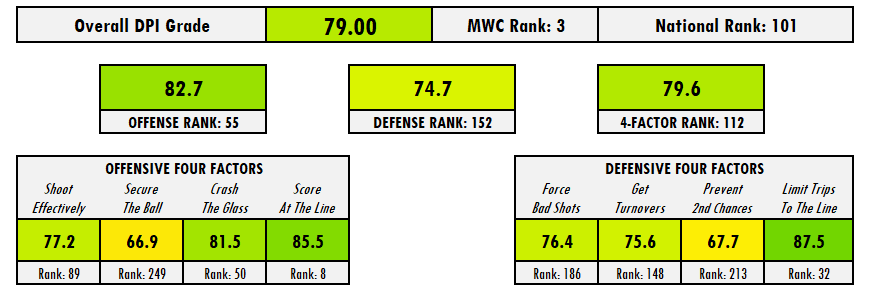
The Lobos have won six straight after toppling New Mexico State and Grand Canyon since the last DPI rankings were posted here. Though they aren’t playing at the level of SDSU just yet, this patchwork roster of homegrown talent and incoming transfers has performed admirably in the early going. JaQuan Lyle has been everything that Paul Weir could have wanted and more. Oh, and Carlton Bragg is averaging a double-double. So far, so good.
#4 — NEVADA WOLF PACK
Last Week: #3
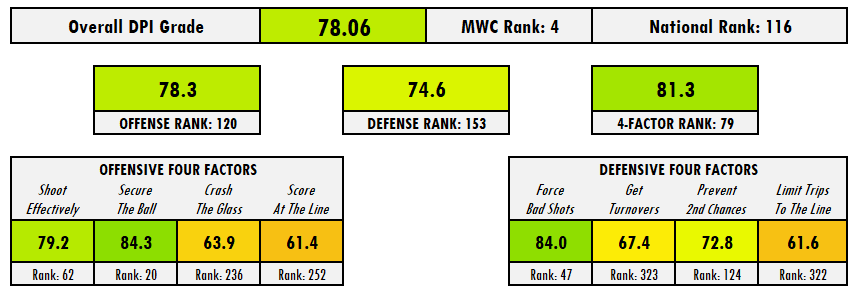
The Wolf Pack looked like they were starting to turn a corner over the past few weeks, winning five straight games on either side of Thanksgiving. But last week, Nevada was the second casualty of BYU’s surge, along with Utah State and UNLV. The offense had been clicking on all cylinders, but immediately downshifted from a 100-point performance against Air Force to a 42-point outing against the Cougars. That kind of volatility that makes it tough to trust Steve Alford’s club.
#5 — BOISE STATE BRONCOS
Last Week: #6
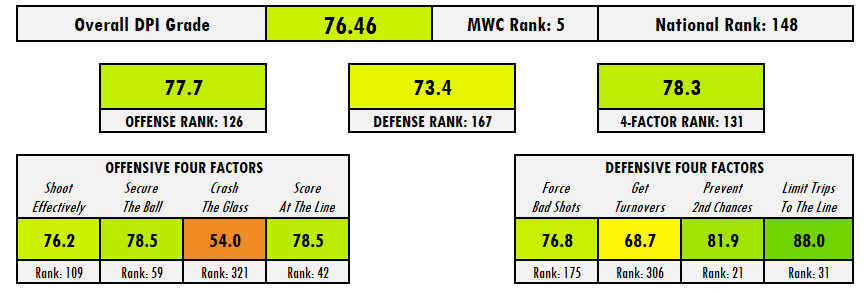
Leon Rice is getting things back on track in Boise, but outside of their win over BYU—before Yoeli Childs came back, of course—the Broncos haven’t really beaten anybody. It was another rocky showing for Boise State last week, with a midweek loss to Tulsa preceding a blowout win over Alabama State. Derrick Alston is averaging 21 points and Justinian Jessup is finding his form. But the starting five is not the problem here; Rice’s team suffers from a lack of depth.
#6 — COLORADO STATE RAMS
Last Week: #5
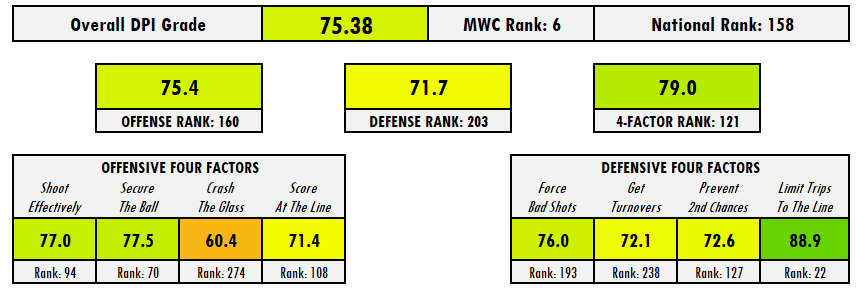
The Rams jumped out to a promising start, but they’ve lost three of their past four games, including both of their opening Mountain West bouts. Mixed in there was a 72-68 win over South Dakota State, and while the Jackrabbits are not a bad squad by any means, that they played CSU so closely gives a good indication of where the Rams are right now. Niko Medved’s team gave in-state rivals Colorado a run for their money, but ultimately fell 56-48 over the weekend.
Final: Air Force 79, Denver 75
Air Force jumped to a 17-point lead, DU forced a tie, AFA pulled back ahead. AJ Walker's FTs with 6 seconds left sealed it and he led the Falcons with 19 points.
Air Force has won 3 of 4.— Brent Briggeman (@BrentBriggeman) December 14, 2019
#7 — AIR FORCE FALCONS
Last Week: #8
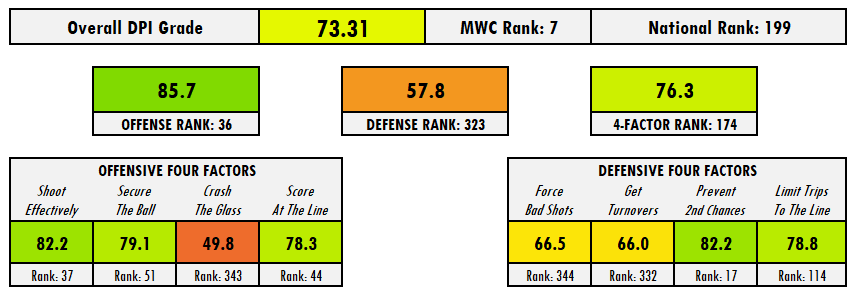
The defense still leaves a lot to be desired, but recently, the Falcons have been getting better results than they did during a rough November. The new month has been kinder to the cadets, with Air Force winning four of its past five (Note: Tuesday’s 99-42 win over Johnson & Wales is not counted in the DPI). AJ Walker has taken an important step forward as an offensive option. The sophomore was averaging 20 points per game over the past three games coming into Tuesday.
#8 — FRESNO STATE BULLDOGS
Last Week: #10
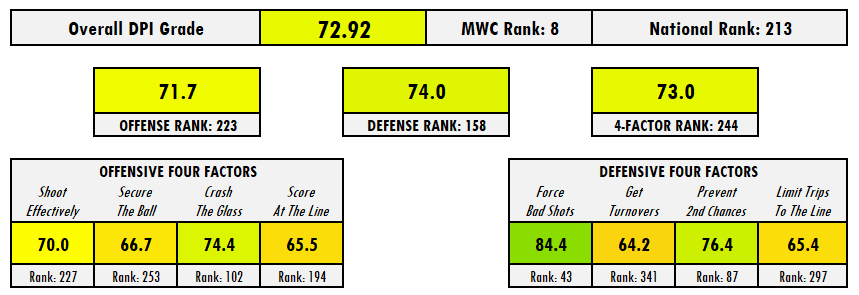
Justin Huston finally got his team to a second Division I win on Saturday against Cal Poly. But the bigger story here is the seven losses that they have already incurred. Nate Grimes is doing exactly what was expected of him so far, averaging a double-double with 13.5 points and 10.4 rebounds per night. Guards Jarred Hyder and New Williams both have some good performances under their belts, but they haven’t been able to click at the same time. That needs to change.
#9 — UNLV RUNNIN’ REBELS
Last Week: #9
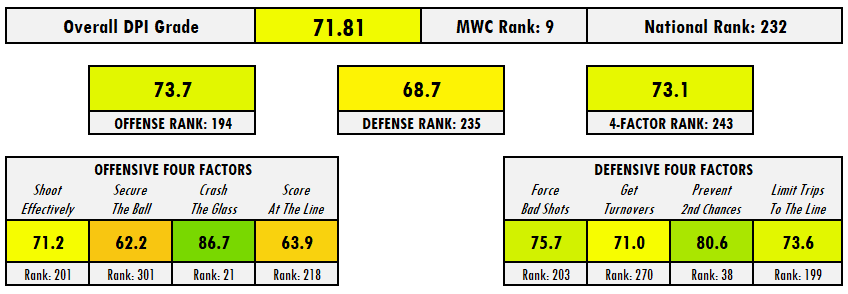
The Rebels didn’t play last week, so the bad taste of the 33-point loss to BYU back has been lingering for a week and a half. There have been a lot of close calls, with UNLV playing in four separate overtime games so far. They are shooting under 42% from the field and turning the ball over 15 times a night. Games against Pacific and Robert Morris this week offer TJ Otzelberger the chance to start making some headway in his first year at the helm.
#10 — WYOMING COWBOYS
Last Week: #7
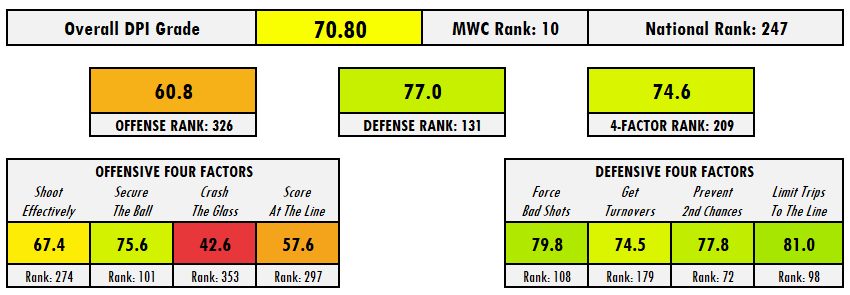
Allen Edwards got his Cowboys out to a 3-3 start, but they have dropped five straight games, including their most recent defeat at the hands of Northern Colorado. The Bears didn’t just sneak past Wyoming, either—the Big Sky hopefuls handed the home team a 21-point drubbing at Arena-Auditorium. The defense has been fair to middling, but the offense has been dreadful thus far. The Cowboys are shooting under 50% on two-pointers and just over 30% on threes.
Does it feel wrong at this point to look at the San Jose State roster and speculate who will transfer at the end of the season?? @andrewdieckhoff @LoboSauce_777
— Larry Muniz (@HardwoodTalk) December 5, 2019
#11 — SAN JOSÉ STATE SPARTANS
Last Week: #11
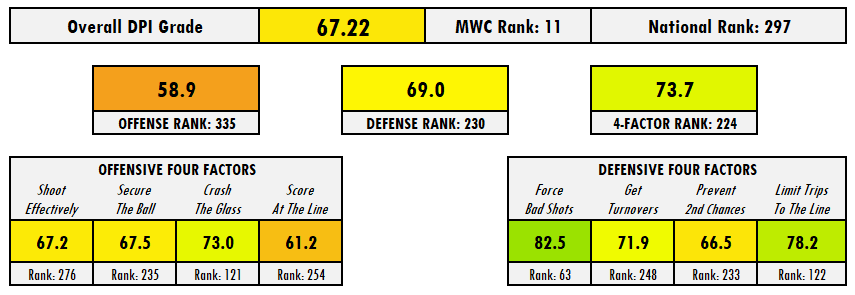
There’s a bit of a running joke around here about which Spartan is most likely to transfer next year, since the sputtering Spartans have seen five double-digit scorers depart in the past three offseasons—including Brandon Clarke, who parlayed his post-SJSU star turn at Gonzaga into a budding NBA career. All jokes aside, Seneca Knight has separated himself as the Spartans’ top option, scoring 12.5 points per game. Hopefully the sophomore can remain an important building block for Jean Prioleau.
That’s it for this week. Check back next week to see who’s rising and falling in the Mountain West and be sure to visit the Dieckhoff Power Index daily for updated rankings on all 353 teams in Division I basketball.
Andrew is a current USBWA member, covering college basketball for multiple outlets, including Mountain West Wire of the USA TODAY Sports Media Group and Busting Brackets of the FanSided Network. He also runs the Dieckhoff Power Index, a college basketball analytics system, and provides bracketology predictions throughout the season.
[lawrence-auto-related count=3 category=1361]

